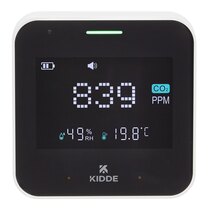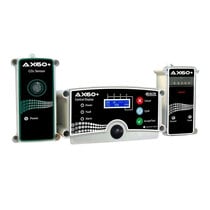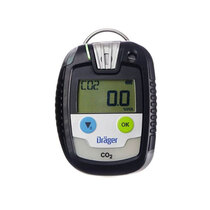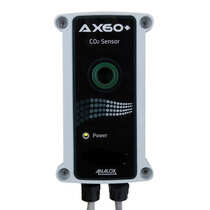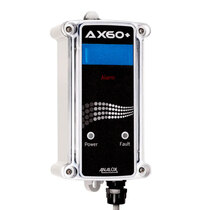-
Contact
Sales & Customer Service
0800 612 6537 support@safelincs.co.uk Live ChatDelivery Enquiries
0800 077 6149 - Resources
Fire & Safety Solutions
CALL OUR TEAM NOW 0800 612 6537
Also FREE from UK mobiles
FREE Delivery
on marked products
Live Chat - Online
Instant help & Advice
Trade Discounts
and exclusive pricing
0% Credit Available
Open an account now
5 Star Customer Feedback
Air Quality Monitors & Carbon Dioxide (CO2) Detectors
Poor indoor air quality affects your health, productivity, and comfort every day. High carbon dioxide levels cause headaches, fatigue, and difficulty concentrating. But you can't see or smell CO2, making it impossible to know when levels become dangerous. What is a CO2 sensor, and how does it work? A CO2 sensor is a device that measures the concentration of carbon dioxide in the air. These sensors use infrared technology to detect CO2 molecules and display readings in parts per million (ppm). When CO2 levels rise above safe thresholds, the sensor alerts you with visual or audible warnings. Most CO2 sensors include additional features, such as temperature and humidity monitoring. This provides a comprehensive view of your indoor environment. Digital displays show real-time readings, making it easy to track air quality throughout the day. Why do you need a CO2 sensor in your home or workplace? Carbon dioxide builds up quickly in enclosed spaces. Every person exhales approximately 1 kilogram of CO2 daily. Without proper ventilation, levels can reach unsafe concentrations within a matter of hours. CO2 levels above 1000ppm indicate poor ventilation. At 5000ppm, you'll experience drowsiness and stuffiness. Levels exceeding 10,000ppm become immediately dangerous. A CO2 sensor warns you before these thresholds are reached. Schools, offices, and meeting rooms benefit most from CO2 monitoring. These spaces often have a high density of people in relatively small areas. Poor air quality reduces learning ability and work performance by up to 15%. What CO2 levels are considered safe? Outdoor air typically contains 400-420ppm of CO2. Indoor levels should remain below 1000 ppm for optimal health and comfort. Here's what different readings mean: 400-800ppm: Excellent air quality Regular monitoring helps you maintain safe levels through proper ventilation timing. How accurate are CO2 sensors? Professional-grade CO2 sensors achieve accuracy within ±30ppm. This precision level meets health and safety standards for most applications. Cheaper consumer models may have accuracy ranges of ±50-100ppm, which is still adequate for general monitoring. Sensor accuracy depends on calibration and maintenance. Most units require annual calibration to maintain precision. Some models include automatic calibration features that adjust readings based on outdoor air reference points. Where should a CO2 sensor be placed? Position your CO2 sensor at breathing height, typically 1.5 to 2 metres from the floor. Avoid placing units near windows, doors, or air vents, as this can skew readings due to the influence of fresh air or drafts. In offices, place sensors in occupied areas rather than corridors. Bedrooms benefit from sensors positioned away from the bed to avoid false readings from exhaled breath. Meeting rooms should have sensors centrally located for representative measurements. Consider multiple sensors for larger spaces. CO2 levels can vary significantly across different areas of the same room. Can CO2 sensors detect other gases? Standard CO2 sensors detect only carbon dioxide. However, many air quality monitors include additional sensors for other harmful gases. These multi-gas detectors can measure: This comprehensive monitoring approach offers enhanced protection and a deeper understanding of your indoor air quality. How often should you calibrate your CO2 sensor? Most CO2 sensors need calibration every 12 months to maintain accuracy. Some units feature automatic baseline calibration, which adjusts readings weekly based on the lowest CO2 levels detected. Manual calibration involves exposing the sensor to known CO2 concentrations, typically 400 ppm of outdoor air. Professional calibration services ensure optimal performance for critical applications, such as schools and hospitals. Signs your sensor needs calibration include consistently high or low readings that don't match ventilation conditions. Ready to improve your indoor air quality? Browse our range of professional CO2 sensors and air quality monitors. Each unit comes with full technical support and calibration guidance. Contact our expert team today to find the perfect solution for your needs. Frequently Asked Questions (FAQs) What's the difference between a CO2 alarm, monitor, and detector? Though these terms are often used interchangeably, they serve different purposes. An alarm features both detection and loud audible warnings for life-threatening situations. A monitor displays precise CO2 readings (often with an accuracy of 0.1%) for air quality assessment, featuring optional alerts. A detector simply analyses CO2 levels and connects to separate sounders in larger systems. Why is CO2 monitoring important in offices and schools? CO2 levels above usual cause drowsiness, headaches, and reduced concentration. Poor ventilation also creates ideal conditions for the transmission of airborne viruses. Installing CO2 monitors in classrooms and offices has become the standard method for ensuring adequate ventilation and maintaining healthy indoor environments. Can CO2 become dangerous in everyday spaces? Yes, but the risk varies by location. In homes and offices, elevated CO2 levels can cause discomfort and health issues, but they are typically not life-threatening. However, in confined spaces like pub cellars, breweries, and laboratories, CO2 can displace oxygen and become lethal. That's why these environments need professional-grade detection systems. Do air quality monitors measure more than just CO2? Many modern air quality monitors are multi-parameter devices that measure temperature, humidity, particulate matter (PM2.5 and PM10), volatile organic compounds (VOCs), and carbon dioxide (CO2) simultaneously. Some innovative models connect to mobile apps and integrate with home automation systems, allowing for automatic control of ventilation. How do I know when CO2 levels are too high? Many monitors use simple "traffic light" colour systems - green for good air quality, amber for caution, and red for action needed. Normal outdoor air contains approximately 400 ppm CO2. Indoor levels should remain below 1000 ppm for comfort; however, concentrations above 5000 ppm can cause noticeable health effects, such as nausea and severe drowsiness. Learn more about the differences between CO and CO2 in our detailed guide.
Read more about air quality monitors & carbon dioxide (CO2) detectors...
800-1000ppm: Good air quality, but consider ventilation
1000-1500ppm: Moderate air quality, ventilation needed
1500-5000ppm: Poor air quality, immediate action required
Above 5000ppm: Dangerous levels, evacuate the area
Mains-Powered Carbon Dioxide (CO2) Air Quality Monitor with "Traffic Light" & Voice Alerts - Kidde KCO2M10
Carbon dioxide is a large contributor to poor air quality indoors, causing tiredness and reducing concentration. Know when to ventilate your room with clear 'traffic light' LEDs & voice alerts.
- Mains powered carbon dioxide monitor with 12hr backup battery
- Digital display of CO2 level, temperature, and humidity
- Clear traffic light indicators to show air quality
- Voice alerts over 1500ppm, which can be muted
Hispec Mains Powered SMART Vape Detector
- Real-time monitoring via TUYA app
- No internal sounder – silent remote alarm via app notification
- The vape detector is designed to cover an area of 30³ (approx. LxWxH 5 x 3 x 2m)
- Device will send a notification if the detector has been tampered with or has been powered off
Analox Ax60+ Fixed CO2 Monitor, Sensor and Alarm Kit
Professional, reliable carbon dioxide detection, monitoring & warning. Ideal for pub cellars, schools, labs, greenhouses, and more.
- Relays can activate fans and gas shut-off valves
- Easy to install Quick Connect fittings – no difficult wiring
- Expandable system, install additional sensors and alarms at any time
- CE marked, UL certified, and EH40 compliant
Dräger PAC 8000 Personal CO2 Detector
Keep personnel working in hazardous environments safe at every moment with wearable gas detection from the world's leading manufacturer.
- Unlimited lifetime – serviceable battery and sensor
- Detects carbon dioxide levels from 0% to 5% by volume
- Superior water and dust ingress protection – IP68
- Light, long-lasting, accurate, reliable life-saving
Analox Ax60+ CO2 Sensor
Expand your Analox gas monitor system with the Ax60+ CO2 sensor. Add up to 4 in any system, easy to retrofit, with Quick Connect for simple installation.
- Up to 4 sensors in a single system
- Can be used alongside Ax60+ oxygen sensors
- Increased coverage for even better life-saving performance
- CE marked, UL certified, and EH40 compliant
Analox Ax60+ Alarm Unit with Blue Strobe
Increase the alarm coverage of your Analox gas monitor system with the Ax60+ alarm and strobe unit. Over 80dB sound output and 100cd blue strobe light.
- Up to 4 alarms per sensor (max 8 in one system)
- Can be used with Ax60+ CO2 and oxygen sensors
- Increased alarm coverage for even wider hazard warning
- CE marked and UL certified
What are air quality monitors?
Air quality monitors are devices designed to measure various contaminants in the air within indoor environments. Their primary purpose is to ensure that the air within a space is safe, clean, and comfortable to breathe. Depending on the exact capabilities of each model, these devices can monitor various parameters such as temperature, humidity, carbon dioxide (CO2), particulate matter (PM2.5 and PM10), and volatile organic compounds (VOCs).
There are several key benefits to using indoor air quality monitors. Firstly, they provide real-time data about the air quality – some with a screen showing the actual reading, others with a simple "traffic light" colour system – enabling individuals to take immediate action if pollutant levels rise above the recommended limits. This could involve opening doors and windows to ventilate the room, adjusting the temperature and humidity levels, or identifying and eliminating the source of pollutants. Secondly, these monitors can help to prevent health issues associated with poor air quality, such as allergies, asthma, and other respiratory conditions. Lastly, they can contribute to overall well-being and productivity, as good air quality has been linked to better sleep, improved concentration, and lower stress levels. Thus, indoor air quality monitors play a crucial role in maintaining a healthy indoor environment.
Some may also be "smart" devices which can connect to a mobile app, allowing users to monitor or be alerted to air quality issues at all times. Some smart air quality monitors may integrate with other smart home systems, potentially allowing the automated control of heating, vents, or air purifiers depending on their readings.
Carbon Dioxide (CO2) Detectors
Safelincs offers a range of carefully selected CO2 monitors, detectors and alarms from leading and trusted manufacturers. These include portable, wearable detectors and fixed multi-sensor alarm systems for environments with potentially toxic carbon dioxide concentrations. Standalone monitors are used for measuring lower levels of CO2 in homes and low-hazard enclosed spaces as this is an excellent indicator of basic air quality. Installing a simple CO2 monitor is fast becoming the de facto method of ensuring good ventilation in offices and school classrooms to reduce transmission of airborne viruses and bacteria.
What is the difference between Monitor, Detector, and Alarm?
These terms are often seen as being interchangeable and there are no hard and fast rules within the smoke, fire and gas detection industry on their use. Where carbon dioxide gas is the hazard, the terms used are even more variable. The most important thing is to understand the features you need and what the product offers, whatever name is used.
Alarm - The term "Alarm" generally refers to a loud audible noise to ensure that persons are made aware of a hazard that is potentially life-threatening. Where non-toxic CO2 levels are measured in order to gauge air quality and feature an audible alert, "Alarm" is often used by some but might be better though of as "Alert", "Warning" or "Notification". As for an Alarm device, this is quite consistently used to mean one which features both a Detector and a Sounder as a single unit. The best example of a safety-critical CO2 alarm would be a personal, portable device worn by operatives moving through environments where high levels of carbon dioxide could be found.
Monitor - A Monitor is typically a device which constantly samples the air for the purposes of measuring air quality rather than warning of an immediate risk to life. Levels of CO2 are displayed to a good degree of accuracy (even down to 0.1%) and may be shown along with temperature and humidity. Monitors may or may not feature an audible warning sounder but most will show some kind of text or symbolic warning, possibly with accompanying colour indicators.
Detector - This term is the most widely used and also the most confusing. Person-worn devices as described above are commonly called "Personal CO2 Detectors" though the purpose is to Alarm the user to danger. However, in a fixed system like those used in breweries, cellars and laboratories, a Detector is simply the unit that analyses the levels of CO2 present; the alarm function is performed by a separate Sounder, and several Detectors and Sounders can be used in one system connected to a Control and Display Unit.
Is carbon dioxide dangerous?
At high a enough concentration carbon dioxide is lethal. Such levels are most often present only in confined spaces and resulting from a human-made process such as those used in manufacturing, chemical production, agriculture, or the beverage industry. CO2 is also a naturally occurring gas at around 0.04% of the atmosphere (400ppm). Carbon dioxide is odourless and colourless so if levels rise they cannot be detected by humans until the effects of overexposure become noticeable.
Because CO2 is heavier than air it will sink in confined spaces and displace oxygen. This process, rather than poisoning by carbon dioxide, is the cause of so many deaths in agriculture. Such tragedies can be avoided by good health and safety practices and provisions, the latter of which includes equipment for measuring CO2 levels and alerting operatives at set trigger levels within their workplace.
At lower concentrations below around 5000ppm, CO2 is generally not harmful but will produce noticeable health effects as levels rise above normal. Symptoms range from mild drowsiness & feelings of a lack of fresh air to headaches, loss of concentration & attention, sleepiness, and nausea. Stale air is also a perfect environment for airborne transmission of diseases, so monitoring CO2 levels is a great way to stay alert and healthy.




















